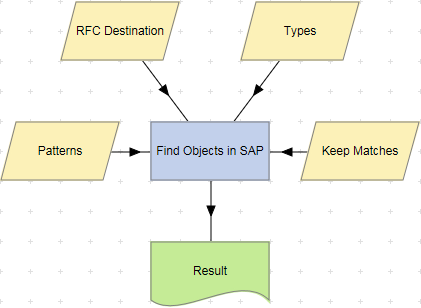Find Objects in SAP Actions
Find Objects in SAP actions retrieve the names of SAP objects of the specified types from a specified RFC Destination. The retrieved object names are stored in a Table dataset with NAME and TYPE columns.
| Action Property | Description |
|---|---|
| Keep Matches | A Boolean parameter which determines whether retrieved object names will be retained in the Result dataset, or discarded. If this parameter is set to ‘true’, retrieved object names that match any of the specified Patterns are stored in the Result table. If this parameter is set to ‘false’, retrieved object names that do not match any of the specified Patterns are stored in the Result table. |
| Patterns | A Table parameter or dataset containing the patterns to be matched against the retrieved object names (optional). |
| Result | A Table dataset in which to store the retrieved object names. |
| RFC Destination | An RFC Destination parameter or dataset referring to the SAP system from which to retrieve object names. |
| Types | A String List parameter containing a list of object types to retrieve. |
If it is specified, the Patterns table should contain the following columns:
| Column | Description |
|---|---|
| TYPE | A value to be matched against the type of each object retrieved. The type ALL matches against all object types. |
| SapQuery (required) | A pattern matched against SAP object names of the specified TYPE to determine which objects to return to the LiveCompare server. The pattern must contain at least one wildcard character (*), which matches against zero or more characters in the object name. |
| Like | The SapQuery pattern expressed in the form required by a SQLite LIKE clause. |
| RegEx (required) | The SapQuery pattern expressed in the form of a Regular Expression. This is used to filter the object names returned to the LiveCompare server. |
| IorE (optional) | If this column is set to ‘I’, object names which match the pattern are included in the matching set. If this column is set to ‘E’, object names which match the pattern are excluded. Each name is matched against the ‘Exclude’ patterns first, and if a match is found the name is not added to the matching set. Otherwise, the name is matched against the ‘Include’ patterns, and added to the matching set if a match is found. If the IorE column is missing or blank, the default is to include matching object names. |
The Find Objects in SAP action supports a number of additional TYPE values, which allow upgrade workflows to retrieve the same objects that are retrieved by the Data Extract program during a LUX analysis. For example:
- The UPGRADE_ALL type is used to retrieve the objects used in the U.01 - Impacted Used Custom Code workflow. The objects are the same as those retrieved by the Data Extract program for the UA01 - Impacted Used Custom Code workflow.
- The UPGRADE_EXEC type is used to retrieve the objects used in the U.02 - Analyze Custom Code Quality workflow. The objects are the same as those retrieved by the Data Extract program for the UA02 - Analyze Custom Code Quality workflow.
Each row in the Patterns table represents a single pattern. A retrieved object name is considered a ‘match’ if it matches at least one of the patterns.
- Patterns that refer to the same object type or table field are logically ORed together.
- Patterns that refer to different object types or table fields are logically ANDed together.
- Excluded patterns are logically ANDed with other patterns.
If a Patterns table is specified that contains at least one entry, object types from the Types list that do not have a pattern specified for them are not retrieved.
The Result dataset has the following columns:
| Column | Description |
|---|---|
| TYPE | The type of a found object. |
| NAME | The name of the found object. |
Example:

To examine the details for a Find Objects in SAP action, double-click the action node, or select ‘View Details’ from the node’s context menu. The Details screen displays the number of rows written to the Result dataset and the time taken for the action to complete.